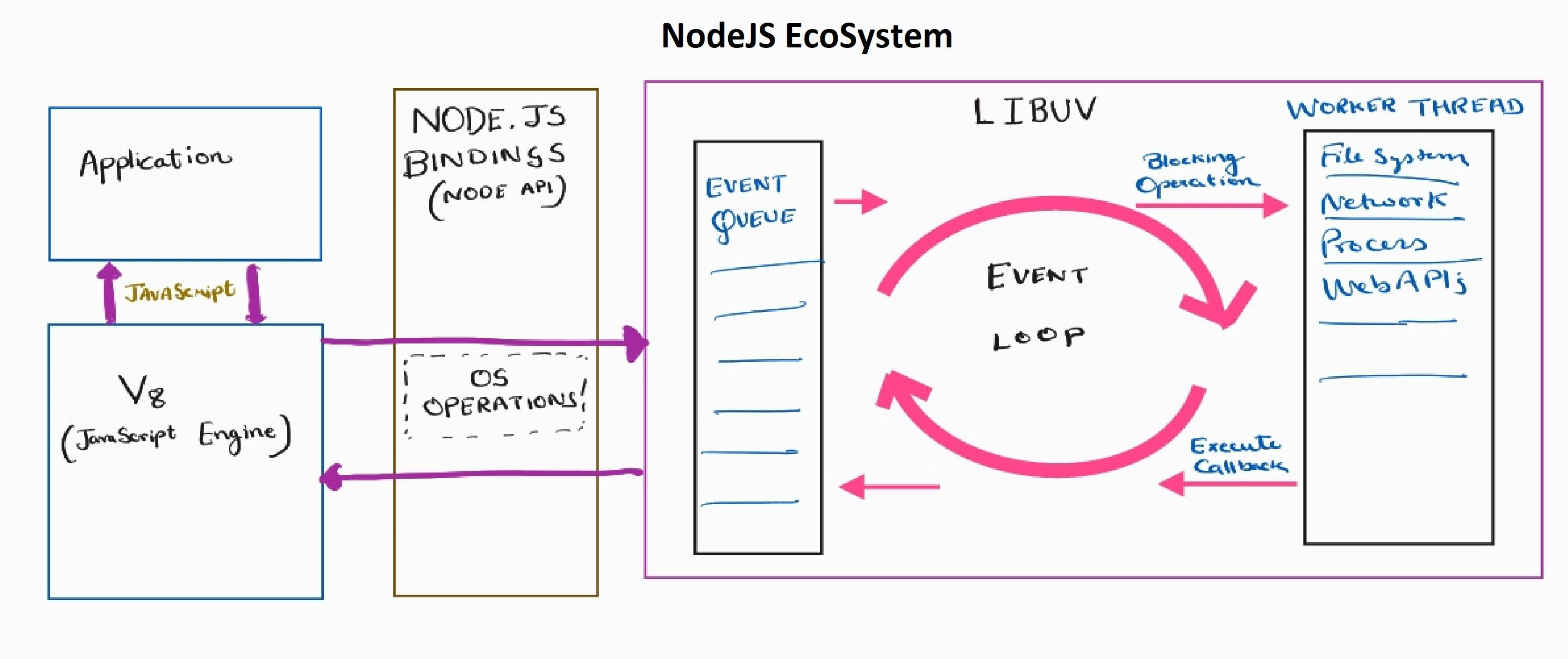#Day16 - Understanding the Node.js Ecosystem and Event Loop
Understand the Node.js ecosystem and event loop. Explore sync vs. async programming, blocking vs non-blocking IO, and the role of the V8 engine, libuv
Introduction
Welcome to the 16th lecture of our 50-day blogging series on back-end development mastery! In this lecture, we will be discussing the Node.js ecosystem and event loop. Understanding these concepts is crucial for any developer working with Node.js, as they form the foundation of how the runtime environment functions.
Before we dive into the Node.js ecosystem and event loop, it's important to understand some concepts
Synchronous vs. Asynchronous Programming
Imagine you are at a restaurant, and you place an order with the server. If the server takes your order, goes into the kitchen, and brings back the food to you, all in one go, without interacting with any other customers in between, this is an example of synchronous behavior. The server is performing one task at a time, and waiting for it to complete before moving on to the next.
On the other hand, if the server takes your order and then immediately goes to take orders from other customers, while the kitchen staff works on preparing your food, this is an example of asynchronous behavior. The server is not waiting for your food to be ready before interacting with other customers.
In programming, synchronous code is executed in a linear, step-by-step fashion. The program waits for one line of code to finish executing before moving on to the next. Asynchronous code, on the other hand, does not have to wait for one task to complete before moving on to the next. This allows for more efficient use of resources, as the program can handle multiple tasks concurrently.
If we are not explicitly telling to the javascript, that we want asynchronous behaviour, then everything is synchronous in javascript.
Blocking vs. Non-blocking IO
Input/output (IO) refers to the transfer of data to and from a program. Blocking IO means that the program must wait for the IO operation to complete before moving on to the next task. Non-blocking IO means that the program can continue executing other tasks while the IO operation is being performed in the background.
Using the restaurant example again, let's say you are the server and you have three customers waiting to place their orders. If you take an order from one customer, go into the kitchen to place the order, and then come back to take orders from the next customer, this is an example of blocking IO. You are waiting for the kitchen to prepare the first order before moving on to the next.
On the other hand, if you take orders from all three customers and then go into the kitchen to place all the orders at once, this is an example of non-blocking IO. You are not waiting for one order to be prepared before taking the next.
Concurrent Language
A concurrent language is one that is designed to handle multiple tasks concurrently. This is achieved through the use of threads, which are separate flow of execution within a program. Node.js is a concurrent language, as it uses a single thread for the event loop and multiple threads for different tasks such as file I/O and networking.
Call Stack
The call stack is a data structure that keeps track of the execution of a program. When a function is called, it is placed on top of the call stack. When the function returns, it is removed from the top of the stack. The call stack is used to keep track of the execution context of a program, which includes the variables and memory allocated for the current function.
In Node.js, the call stack is used to keep track of the functions that are being executed. When a function is called, it is placed on the top of the stack. When the function returns, it is removed from the top of the stack. This allows the program to keep track of the order in which functions are called and returned, and any variables or memory that are associated with those functions.
Event Loop
The event loop is a central part of the Node.js runtime environment. It is responsible for handling the non-blocking, asynchronous nature of the language by continuously checking for events and delegating them to the appropriate event handlers.
The event loop works in conjunction with the call stack and a callback queue. When a function is called, it is placed on the call stack and executed. If the function contains an asynchronous operation, such as a file I/O or a network request, the event loop will register a callback function to be executed once the operation is complete. The callback function is then placed in the callback queue, waiting to be executed.
Once the call stack is empty, the event loop checks the callback queue for any pending callback functions. If it finds any, it pushes the callback function onto the call stack and executes it. This process continues until there are no more callback functions in the queue.
The event loop is what allows Node.js to handle multiple asynchronous tasks concurrently, without the need for multiple threads. It is a crucial part of the Node.js ecosystem and is what makes it possible to build high performance, scalable applications.
If you want to learn more about the event loop and how it works, we recommend watching the video "What the heck is the event loop anyway?" by Philip Roberts. https://youtu.be/8aGhZQkoFbQ It's a great resource for understanding this complex topic.
Callback Queue and Other APIs
In addition to the event loop, there are other APIs in the Node.js ecosystem that work with it to enable non-blocking, asynchronous behavior. The callback queue is one of these APIs. It is where callback functions are stored until they are ready to be executed by the event loop.
There are also other APIs such as the file system API, which allows you to read and write files asynchronously, and the network API, which enables you to make network requests asynchronously. These APIs make use of the event loop and callback queue to enable non-blocking behavior.
Node.js Ecosystem
The Node.js ecosystem consists of several components that work together to execute JavaScript code outside of the browser. The main component is the V8 engine, which is a JavaScript runtime engine developed by Google for use in the Chrome browser. Node.js uses a modified version of the V8 engine to execute JavaScript code on the server side.

The Node.js ecosystem also includes the heap and stack, which are areas of memory used to store data and execute code. The heap is used to store dynamically allocated memory, while the stack is used to store the execution context of functions.
The Node.js ecosystem includes two main dependencies: libuv and V8. Libuv is a C library that provides the non-blocking I/O operations and the event loop, while V8 is a C++ library that provides the JavaScript runtime engine. Libuv acts as a bridge between Node.js and the operating system, taking care of tasks such as networking, file system operations, and thread management.
The event loop is a central part of the Node.js runtime environment. It is responsible for handling the non-blocking, asynchronous nature of the language by continuously checking for events and delegating them to the appropriate event handlers. The event loop works in conjunction with the call stack and a callback queue. When a function is called, it is placed on the call stack and executed. If the function contains an asynchronous operation, such as a file I/O or a network request, the event loop will register a callback function to be executed once the operation is complete. The callback function is then placed in the callback queue, waiting to be executed.
Once the call stack is empty, the event loop checks the callback queue for any pending callback functions. If it finds any, it pushes the callback function onto the call stack and executes it. This process continues until there are no more callback functions in the queue.
The event loop is what allows Node.js to handle multiple asynchronous tasks concurrently, without the need for multiple threads. It is a crucial part of the Node.js ecosystem and is what makes it possible to build high performance, scalable applications.
In addition to the event loop, there are other APIs in the Node.js ecosystem that work with it to enable non-blocking, asynchronous behavior. These APIs, such as the file system API and the network API, are built on top of the V8 engine and libuv, and make use of the event loop and callback queue to enable non-blocking behavior.
By taking care of all these points, we can see how the various components of the Node.js ecosystem work together to execute JavaScript code and enable non-blocking, asynchronous behavior in the runtime environment.
Conclusion
In this lecture, we discussed the Node.js ecosystem and event loop, and how they work together to enable non-blocking, asynchronous behavior in the runtime environment. We covered the concepts of synchronous and asynchronous programming, blocking and non-blocking IO, and the call stack and event loop. We also introduced the callback queue and other APIs in the Node.js ecosystem.
We hope this lecture has given you a better understanding of these important concepts.
Thankyou for reading the blog
